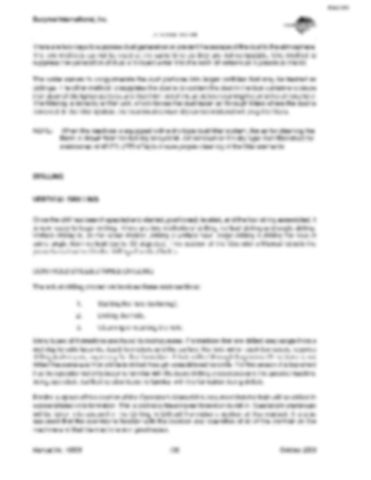BI619852
Bucyrus International, Inc. 59HR Blast Hole Drill
There are two ways to suppress dust generation or prevent the escape of the dust to the atmosphere. The two methods cannot be used at the same time as they are not compatible. One method to suppress the generation of dust is to inject water into the main air stream as it passes to the bit. The water serves to conglomerate the dust particles into larger particles that may be treated as cuttings. The other method to suppress the dust is to contain the dust in the dust curtain enclosure then draw off the lighter particles and filter them out of the air before returning the air to the atmosphere. The filtering is done by a filter unit, which forces the dust laden air through filters where the dust is removed. In the filter system, the dust must remain dry as wet material will plug the filters. NOTE:
When the machine is equipped with a dry-type dust filter system, the air for cleaning the filters is drawn from the bailing air system. Air pressure to the dry-type dust filter must be maintained at 40 PSI (276 kPa) to insure proper cleaning of the filter elements.
DRILLING
VERTICAL DRILLING Once the drill has been inspected and started, positioned, leveled, and the tool string assembled, it is now ready to begin drilling. There are two methods of drilling, vertical drilling and angle drilling. Vertical drilling is, as the name implies, drilling a vertical hole. Angle drilling is drilling the hole at some angle from vertical (up to 30 degrees). This section of the Operator’s Manual details the procedures involved in the drilling of vertical holes. CONTROLS UTILIZED WHILE DRILLING The actual drilling procedure involves three main sections: 1.
Starting the hole (collaring).
2.
Drilling the hole.
3.
Cleaning or reaming the hole.
Many types of formations are found in mining areas. Formations that are drilled may range from a wet clay to solid taconite. Each formation, and the parts of the hole within each formation, requires drilling techniques, expressly for that formation. A hole drilled through fragmented limestone is not drilled the same way that a hole is drilled through consolidated taconite. For this reason it is important that the operator not only become familiar with the basic drilling procedures and the specific machine being operated, but that he also become familiar with the formation being drilled. For the purpose of this section of the Operator’s Manual it is assumed that the hole will be drilled in a consolidated rock formation. This is probably the simplest formation to drill in. Special circumstances will be taken into account in the Drilling In Difficult Formations section of this manual. It is also assumed that the operator is familiar with the location and operation of all of the controls on the machine and that the machine is in good repair. Manual No. 10836
100
October 2009


